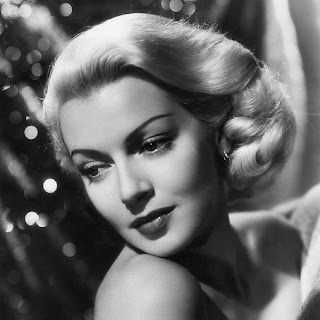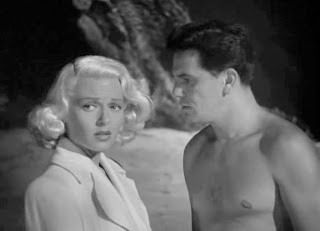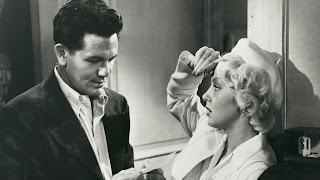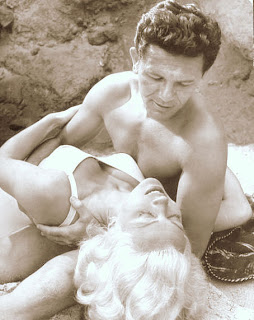 John Garfield came from the same neighborhood that wrought and molded other entertainment greats like Paul Muni, Edward G. Robinson, George and Ira Gershwin, Eddie Cantor and Leonard Bernstein. There were two venues for improving one's lot in those days: school or crime. Garfield tended to exaggerate his involvement in gangs. "I suppose it was a fifty-fifty chance then which I would achieve-Sing Sing or Hollywood," he once boasted. Still, Garfield acknowledged that the worst crimes he ever committed were swiping vegetables from street vendors and baiting cops to chase him.
John Garfield came from the same neighborhood that wrought and molded other entertainment greats like Paul Muni, Edward G. Robinson, George and Ira Gershwin, Eddie Cantor and Leonard Bernstein. There were two venues for improving one's lot in those days: school or crime. Garfield tended to exaggerate his involvement in gangs. "I suppose it was a fifty-fifty chance then which I would achieve-Sing Sing or Hollywood," he once boasted. Still, Garfield acknowledged that the worst crimes he ever committed were swiping vegetables from street vendors and baiting cops to chase him. "Even in a great picture like Body and Soul. There was no meanness in him. He didn't have that streak of killer in him", journalist Sam Shaw said. Michael J. Coppola, a classmate of Garfield's in junior high school, agreed. "He wasn't that tough. He was a really nice kid. I don't know where they got that image that he was a tough guy."
"Even in a great picture like Body and Soul. There was no meanness in him. He didn't have that streak of killer in him", journalist Sam Shaw said. Michael J. Coppola, a classmate of Garfield's in junior high school, agreed. "He wasn't that tough. He was a really nice kid. I don't know where they got that image that he was a tough guy." He learned early on never to back away from a fight. He didn't always win-his short stature at the time (about 5'5") was a handicap, but he fought with a ferocity that made up for his physical shortcomings. "He was a sad kid," recalled classmate Michael J. Coppola. "A loner. Maybe because he was Jewish and felt out of place with all the Italians here." All of his close friends always called Garfield "Julie".
He learned early on never to back away from a fight. He didn't always win-his short stature at the time (about 5'5") was a handicap, but he fought with a ferocity that made up for his physical shortcomings. "He was a sad kid," recalled classmate Michael J. Coppola. "A loner. Maybe because he was Jewish and felt out of place with all the Italians here." All of his close friends always called Garfield "Julie". While there was an element of "wolf" in his attitude, he also seemed naive, a trait that Robbe (his wife) found disarming. The couple were soon spending hours talking on park benches, taking in the early talking pictures at the local movie house, and making out wherever and whenever they could. He fell for her harder than she fell for him, partially because he was so desperate to have a stable relationship with someone who showed him affection.
While there was an element of "wolf" in his attitude, he also seemed naive, a trait that Robbe (his wife) found disarming. The couple were soon spending hours talking on park benches, taking in the early talking pictures at the local movie house, and making out wherever and whenever they could. He fell for her harder than she fell for him, partially because he was so desperate to have a stable relationship with someone who showed him affection. Garfield was financially surviving thanks to a job selling Margaret Sanger-endorsed diaphragms to medical offices (the women secretaries blushed when he came in). He knew he needed to gain more experience in the theater, and he understood the value of theatrical training. He enrolled in acting classes held in the basement of the Civic Rep. One of the guest lecturers was 24-year-old Clifford Odets, an aspiring playwright and actor who had played small roles in several Guild productions. Garfield and Odets were immediately drawn to each other; the younger man saw in Odets another father figure in the mold of Angelo Patri. Garfield was fascinated with Odets' rambling dissertations on life, theater and women, while Odets was constantly amused by Garfield's candor and innocence.
Garfield was financially surviving thanks to a job selling Margaret Sanger-endorsed diaphragms to medical offices (the women secretaries blushed when he came in). He knew he needed to gain more experience in the theater, and he understood the value of theatrical training. He enrolled in acting classes held in the basement of the Civic Rep. One of the guest lecturers was 24-year-old Clifford Odets, an aspiring playwright and actor who had played small roles in several Guild productions. Garfield and Odets were immediately drawn to each other; the younger man saw in Odets another father figure in the mold of Angelo Patri. Garfield was fascinated with Odets' rambling dissertations on life, theater and women, while Odets was constantly amused by Garfield's candor and innocence. Romantic relationships continued to thrive within the Group, with Paula Miller marrying Strasberg, Clurman and Stella Adler becoming lovers, and Cheryl Crawford taking up with actress Dorothy Patten. Odets continued to strike out in his efforts to seduce the Group's resident actresses. Norman Lloyd, who was then working with Orson Welles in the Mercury Theatre, said: "This was the great lie we lived, 'Oh, we're great artists, you see, we want pure theater.' But secretly, the truth was, we all wanted to go to Hollywood."
Romantic relationships continued to thrive within the Group, with Paula Miller marrying Strasberg, Clurman and Stella Adler becoming lovers, and Cheryl Crawford taking up with actress Dorothy Patten. Odets continued to strike out in his efforts to seduce the Group's resident actresses. Norman Lloyd, who was then working with Orson Welles in the Mercury Theatre, said: "This was the great lie we lived, 'Oh, we're great artists, you see, we want pure theater.' But secretly, the truth was, we all wanted to go to Hollywood." Jack Warner shaking John Garfield's hand shortly before his Warner contract was to run out
Jack Warner shaking John Garfield's hand shortly before his Warner contract was to run outIt's fair to say that the closest thing to the social consciousness prevalent in the New York theater was found in the Warner Bros. films. John Garfield typified the Warner type: dark, brooding, street-smart and a native New Yorker to boot (is it coincidence that Muni, Cagney, Raft and Bogart, as well as Garfield, were all New York City born?).
 Julius Epstein said he wrote the role of Mickey Borden in "Four Daughters" with actor Van Heflin in mind, so both Epsteins had a vested interest in who played the part. But when they met Garfield on his arrival at the studio, they took a liking to him. Borden's a character, no doubt about it. His hair is heading straight towards the ceiling, his tie is at half-mast and his cigarette perpetually hangs out of his mouth, curled over his lower lip like a permanent extension.
Julius Epstein said he wrote the role of Mickey Borden in "Four Daughters" with actor Van Heflin in mind, so both Epsteins had a vested interest in who played the part. But when they met Garfield on his arrival at the studio, they took a liking to him. Borden's a character, no doubt about it. His hair is heading straight towards the ceiling, his tie is at half-mast and his cigarette perpetually hangs out of his mouth, curled over his lower lip like a permanent extension. Borden is amused by the Lemps' middle-class lifestyle. "A rug on the floor, the smell of cooking in the kitchen, a piano, and flowers," he cynically notes. "It's homes like these that are the backbone of the nation." Not only a dark cynic, but a rebel, Borden also gets a lot of funny lines. Garfield played him with just the right balance of humor and despair. Even when he's on the inside, he somehow ends up being an outsider. At one point Etta grandly offers Mickey a cup of tea. He accepts with a bite: "You needn't look so noble. Tea is only a little hot water." Maybe "Four Daughters" shouldn't hold up today, but it does. All the actors give winning performances and the dialogue is still sharp and funny over 60 years later. The New York Times' Bosley Crowther, who wrote of the film, "it may be sentimental, but it's grand cinema," felt Garfield's interpretation of Mickey Borden was "the most startling innovation in the way of a screen character in years."
Borden is amused by the Lemps' middle-class lifestyle. "A rug on the floor, the smell of cooking in the kitchen, a piano, and flowers," he cynically notes. "It's homes like these that are the backbone of the nation." Not only a dark cynic, but a rebel, Borden also gets a lot of funny lines. Garfield played him with just the right balance of humor and despair. Even when he's on the inside, he somehow ends up being an outsider. At one point Etta grandly offers Mickey a cup of tea. He accepts with a bite: "You needn't look so noble. Tea is only a little hot water." Maybe "Four Daughters" shouldn't hold up today, but it does. All the actors give winning performances and the dialogue is still sharp and funny over 60 years later. The New York Times' Bosley Crowther, who wrote of the film, "it may be sentimental, but it's grand cinema," felt Garfield's interpretation of Mickey Borden was "the most startling innovation in the way of a screen character in years." Film historians have cited Mickey Borden as being the first screen rebel character in cinematic history, which in turn makes John Garfield the first antihero of film.
Film historians have cited Mickey Borden as being the first screen rebel character in cinematic history, which in turn makes John Garfield the first antihero of film. Film director/writer Abraham Polonsky believed that the sexual affairs were just part of the business of Hollywood. "When you're a real star in this town there's no way you can avoid some sort of sexual confrontation," he said. "It's pushed all over you. It's part of the way people show their admiration for you, get pleasure out of their association with you."
Film director/writer Abraham Polonsky believed that the sexual affairs were just part of the business of Hollywood. "When you're a real star in this town there's no way you can avoid some sort of sexual confrontation," he said. "It's pushed all over you. It's part of the way people show their admiration for you, get pleasure out of their association with you." Garfield often responded to these sexual advances because they reaffirmed that he was good at something (besides acting). Many of his friends believed that his promiscuity was just another symptom of his quest for approval. Garfield confided to artist Charles Schlein about his infidelities and talked about how much he loved Robbe and Katherine. "What was really important to him," said Charlie's wife Gerry, "was his marriage and his family. He was a good father. He loved his daughter. His marriage may have been rocky at times, but he loved Robbe. I think she was solid. He depended on her a great deal. She was a center that he could hold on to."
Garfield often responded to these sexual advances because they reaffirmed that he was good at something (besides acting). Many of his friends believed that his promiscuity was just another symptom of his quest for approval. Garfield confided to artist Charles Schlein about his infidelities and talked about how much he loved Robbe and Katherine. "What was really important to him," said Charlie's wife Gerry, "was his marriage and his family. He was a good father. He loved his daughter. His marriage may have been rocky at times, but he loved Robbe. I think she was solid. He depended on her a great deal. She was a center that he could hold on to."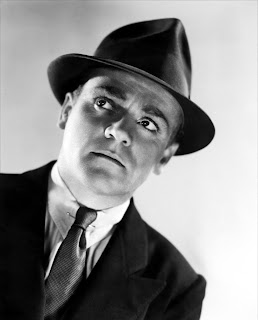 "James Cagney never generated a real feeling for his characters, or a feeling of getting on with the people around him, the people whom he loved. James Cagney had the force, but John Garfield had the force and the humanity," Abraham Polonsky claimed in The Un-Americans: the Blacklist, and Stoolpigeon Culture (2009) by Joseph Litvak.
"James Cagney never generated a real feeling for his characters, or a feeling of getting on with the people around him, the people whom he loved. James Cagney had the force, but John Garfield had the force and the humanity," Abraham Polonsky claimed in The Un-Americans: the Blacklist, and Stoolpigeon Culture (2009) by Joseph Litvak. Garfield was a liberal, but never a communist. He signed political petitions as easily as he would sign an autograph for a fan. He endorsed the Medical Bureau of the North American Committee to Aid Spanish Democracy, which meant that he supported efforts to send humanitarian and medical aid to the Loyalists in Spain. The studio did allow him to participate in the "Salute to Roosevelt" radio broadcast (1940), along with Edward G. Robinson and Humphrey Bogart.
Garfield was a liberal, but never a communist. He signed political petitions as easily as he would sign an autograph for a fan. He endorsed the Medical Bureau of the North American Committee to Aid Spanish Democracy, which meant that he supported efforts to send humanitarian and medical aid to the Loyalists in Spain. The studio did allow him to participate in the "Salute to Roosevelt" radio broadcast (1940), along with Edward G. Robinson and Humphrey Bogart. Columbia, having bought the film rights to "Golden Boy", wanted John Garfield as Joe Bonaparte. Warner wouldn't deal with studio head Harry Cohn (they were feuding at the time) and the role went to newcomer William Holden. For the second time, Garfield missed out on playing the role that Clifford Odets had created for him. Years later Garfield told actor Robert Blake that not being able to play Joe Bonaparte on film was "one of the biggest heartbreaks of my career."
Columbia, having bought the film rights to "Golden Boy", wanted John Garfield as Joe Bonaparte. Warner wouldn't deal with studio head Harry Cohn (they were feuding at the time) and the role went to newcomer William Holden. For the second time, Garfield missed out on playing the role that Clifford Odets had created for him. Years later Garfield told actor Robert Blake that not being able to play Joe Bonaparte on film was "one of the biggest heartbreaks of my career."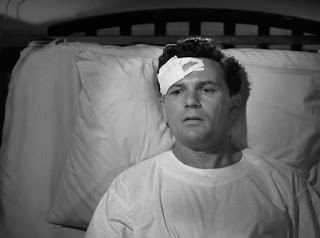 Garfield displayed his newfound maturity as Frank Chambers, a man driven by love and lust to kill, and infused the character with a sense of vulnerability and fear. Chambers is really the antithesis of the type of character he had perfected at Warner Bros. Watching the film, you may find it hard to blame Chambers, especially since he became a murderer to please Lana Turner (Cora), who never looked hotter on film.
Garfield displayed his newfound maturity as Frank Chambers, a man driven by love and lust to kill, and infused the character with a sense of vulnerability and fear. Chambers is really the antithesis of the type of character he had perfected at Warner Bros. Watching the film, you may find it hard to blame Chambers, especially since he became a murderer to please Lana Turner (Cora), who never looked hotter on film. "He was shy, vibrant and intelligent," Turner said of Garfield during a 1973 film homage for her at New York City's Town Hall. "And so ahead of his time. He had terrific magnetism. The lines bounced back and forth between us. It kept a girl on her toes." Instead of playing sly, Garfield figured candor was the best policy. One afternoon he said to Lana Turner, "How about it? Let's go down to the beach tonight." Turner was all for it. The moon cooperated fully. So did the sea.
"He was shy, vibrant and intelligent," Turner said of Garfield during a 1973 film homage for her at New York City's Town Hall. "And so ahead of his time. He had terrific magnetism. The lines bounced back and forth between us. It kept a girl on her toes." Instead of playing sly, Garfield figured candor was the best policy. One afternoon he said to Lana Turner, "How about it? Let's go down to the beach tonight." Turner was all for it. The moon cooperated fully. So did the sea. Bosley Crowther said that the film "comes off a tremendously tense and dramatic show, and it gives Lana Turner and John Garfield the best roles of their careers. Mr. Garfield reflects to the life the crude and confused young hobo who stumbled aimlessly into a fatal trap."
Bosley Crowther said that the film "comes off a tremendously tense and dramatic show, and it gives Lana Turner and John Garfield the best roles of their careers. Mr. Garfield reflects to the life the crude and confused young hobo who stumbled aimlessly into a fatal trap." Garfield possessed a charitable spirit towards those in need, including children. During the filming of "Nobody Lives Forever" the company had traveled to the historic Mission San Capistrano to shoot a scene between Garfield and Geraldine Fitzgerald. The villagers there made their living by selling locally-grown walnuts to tourists, he encouraged the cast and crew to buy all the walnuts in stock. He anted up most of the money himself. This generosity tended to attract selfish characters; an array of con men, hangers-on and losers, the sort of riffraff one expected to see in a Warner Bros. crime drama. At the Hoyle Club he played poker and lost most of the time. "He had a coterie of decrepit characters who I found very repulsive," Helen Levitt explained. "There was a pugilist, a writer and a lot of would-be actors. I guess they acted as bodyguards. A movie star needs some kind of protection but I think he needed protection from them."
Garfield possessed a charitable spirit towards those in need, including children. During the filming of "Nobody Lives Forever" the company had traveled to the historic Mission San Capistrano to shoot a scene between Garfield and Geraldine Fitzgerald. The villagers there made their living by selling locally-grown walnuts to tourists, he encouraged the cast and crew to buy all the walnuts in stock. He anted up most of the money himself. This generosity tended to attract selfish characters; an array of con men, hangers-on and losers, the sort of riffraff one expected to see in a Warner Bros. crime drama. At the Hoyle Club he played poker and lost most of the time. "He had a coterie of decrepit characters who I found very repulsive," Helen Levitt explained. "There was a pugilist, a writer and a lot of would-be actors. I guess they acted as bodyguards. A movie star needs some kind of protection but I think he needed protection from them." From about 1946 on, John Garfield was one of the artists working the night shift at the Dream Factory that Film Historian Eddie Muller wrote about. His characters never wore a trench coat, and it was hard for the femme fatales of noir to really get their nails into them, generally coming to his senses and realizing that the price he had to pay to stay in that world was too high.
From about 1946 on, John Garfield was one of the artists working the night shift at the Dream Factory that Film Historian Eddie Muller wrote about. His characters never wore a trench coat, and it was hard for the femme fatales of noir to really get their nails into them, generally coming to his senses and realizing that the price he had to pay to stay in that world was too high. Garfield made four noir films between 1947 and 1951; three for his own production company: Body and Soul (1947), Force of Evil (1948), and He Ran All The Way (1951) and one for Warner Bros., The Breaking Point (1950). These films, along with The Postman Always Rings Twice, have cemented his position as a major noir actor. Unlike other noir actors -like Dick Powell, Robert Mitchum or John Payne- Garfield, as a film producer, helped create his own noir world.
Garfield made four noir films between 1947 and 1951; three for his own production company: Body and Soul (1947), Force of Evil (1948), and He Ran All The Way (1951) and one for Warner Bros., The Breaking Point (1950). These films, along with The Postman Always Rings Twice, have cemented his position as a major noir actor. Unlike other noir actors -like Dick Powell, Robert Mitchum or John Payne- Garfield, as a film producer, helped create his own noir world. Director Robert Rossen wanted his hero Charley Davis dead in "Body and Soul". Abe Polonsky wanted his script respected. Garfield sided with Polonsky; producer Bob Roberts was more ambivalent. Polonsky's ending remained. Rossen was unhappy about the strained partnership with Polonsky.
Director Robert Rossen wanted his hero Charley Davis dead in "Body and Soul". Abe Polonsky wanted his script respected. Garfield sided with Polonsky; producer Bob Roberts was more ambivalent. Polonsky's ending remained. Rossen was unhappy about the strained partnership with Polonsky. The Mirror's Jack Thompson noted that the film was "probably the most realistic and honest story of prize fighting yet brought to the screen."
The Mirror's Jack Thompson noted that the film was "probably the most realistic and honest story of prize fighting yet brought to the screen." "It's a striking commentary on Hollywood and its waste of talents that Garfield, an actor who was perfectly capable of doing this job nine years ago when he first left the New York stage, should have had to wait so long and impersonate so many variously repetitious types before he could realize his full capabilities," Archer Winston of The New York Post wrote.
"It's a striking commentary on Hollywood and its waste of talents that Garfield, an actor who was perfectly capable of doing this job nine years ago when he first left the New York stage, should have had to wait so long and impersonate so many variously repetitious types before he could realize his full capabilities," Archer Winston of The New York Post wrote. Conversing with Academy programmer Randy Haberkamp, Julie Garfield noted similarities between her father in real life -he refused to betray his colleagues naming names when he testified before HUAC two years after playing his role in “Body and Soul”: “It's so strange that he made this film. He [too] didn’t sell out.”
Conversing with Academy programmer Randy Haberkamp, Julie Garfield noted similarities between her father in real life -he refused to betray his colleagues naming names when he testified before HUAC two years after playing his role in “Body and Soul”: “It's so strange that he made this film. He [too] didn’t sell out.” The Committee for the First Amendment sat in the hearing rooms in quiet gloom. Garfield, appalled at the hearings, took a step to publicly denounce them on the stairs outside the Caucus Room. Standing next to the Epstein Brothers, he waved a statement that he co-signed with Henry Fonda, Paulette Goddard, Myrna Loy, Gregory Peck, Katharine Hepburn, Van Heflin, Eddie Cantor and others.
The Committee for the First Amendment sat in the hearing rooms in quiet gloom. Garfield, appalled at the hearings, took a step to publicly denounce them on the stairs outside the Caucus Room. Standing next to the Epstein Brothers, he waved a statement that he co-signed with Henry Fonda, Paulette Goddard, Myrna Loy, Gregory Peck, Katharine Hepburn, Van Heflin, Eddie Cantor and others. "These actors are disgusted and outraged by the continuing attempts of the House Un-American Committee to smear the motion picture industry," he said. Bogart was among the first to distance himself from The Committee for the First Amendment. Gene Kelly said, "People were afraid. They had wives and kids to support. They just caved in. Even the movie moguls, who knew the blacklist was wrong, gave in." "I am a Rooseveltian New Dealer", Garfield stated, "The trouble is liberalism is unpopular today and anybody who is for the underdog gets labeled a red."
"These actors are disgusted and outraged by the continuing attempts of the House Un-American Committee to smear the motion picture industry," he said. Bogart was among the first to distance himself from The Committee for the First Amendment. Gene Kelly said, "People were afraid. They had wives and kids to support. They just caved in. Even the movie moguls, who knew the blacklist was wrong, gave in." "I am a Rooseveltian New Dealer", Garfield stated, "The trouble is liberalism is unpopular today and anybody who is for the underdog gets labeled a red." "No matter how, a man alone ain't got no bloody fucking chance." -HARRY MORGAN in ERNEST HEMINGWAY'S NOVEL "TO HAVE AND HAVE NOT" (1937)
"No matter how, a man alone ain't got no bloody fucking chance." -HARRY MORGAN in ERNEST HEMINGWAY'S NOVEL "TO HAVE AND HAVE NOT" (1937) Morgan is the owner of a small fishing boat; a guy who is willing to play along, but who doesn't know what game he's playing. He's 40 or so, and has a wife (Phyllis Thaxter) and two kids. He even has a little house by the bay, the sort of place Mickey Borden sneered at.
Morgan is the owner of a small fishing boat; a guy who is willing to play along, but who doesn't know what game he's playing. He's 40 or so, and has a wife (Phyllis Thaxter) and two kids. He even has a little house by the bay, the sort of place Mickey Borden sneered at. Leona (Patricia Neal), is threatening the stability of his marriage. Morgan is suffering from low self-esteem: he can't be a good father, he doesn't seem to be a good husband, and the finance company is planning to take his boat-his livelihood away from him. Harry Morgan was John Garfield in 1950. Later he said of the film, "I think it's the best I've done since 'Body and Soul'. Better than that."
Leona (Patricia Neal), is threatening the stability of his marriage. Morgan is suffering from low self-esteem: he can't be a good father, he doesn't seem to be a good husband, and the finance company is planning to take his boat-his livelihood away from him. Harry Morgan was John Garfield in 1950. Later he said of the film, "I think it's the best I've done since 'Body and Soul'. Better than that." Blond supporting actress Patricia Neal was then involved in a torrid romance with Gary Cooper and met Garfield for the first time at a pre-production party in Hollywood. She recalled she didn't know how to take him. "He was a funny man, but I didn't quite understand him". "He came up to me while I was sitting on a couch and he introduced himself, and then he began hitting me on the arm with his hand.
Blond supporting actress Patricia Neal was then involved in a torrid romance with Gary Cooper and met Garfield for the first time at a pre-production party in Hollywood. She recalled she didn't know how to take him. "He was a funny man, but I didn't quite understand him". "He came up to me while I was sitting on a couch and he introduced himself, and then he began hitting me on the arm with his hand.
 Shooting one scene of "The Breaking Point", Garfield took an extra moment to respond to one of the other actors. Curtiz stopped the cameras and chided him for forgetting his line. "I didn't forget my lines," Garfield said, "I was acting." Curtiz didn't get it. "It's got to be tender and its got to be violent," was the extent of his direction for a seduction scene between Patricia Neal and Garfield. The actors were utterly confused.
Shooting one scene of "The Breaking Point", Garfield took an extra moment to respond to one of the other actors. Curtiz stopped the cameras and chided him for forgetting his line. "I didn't forget my lines," Garfield said, "I was acting." Curtiz didn't get it. "It's got to be tender and its got to be violent," was the extent of his direction for a seduction scene between Patricia Neal and Garfield. The actors were utterly confused. Martha O'Driscoll and John Garfield as Whitney and John in "The Fallen Sparrow" (1943) directed by Richard Wallace
Martha O'Driscoll and John Garfield as Whitney and John in "The Fallen Sparrow" (1943) directed by Richard Wallace "You know, I'm not the kind of actor that becomes a star in Hollywood," Garfield told Archer Winston. "I would normally have been a character actor, but Mike Curtiz made me a star in 'Four Daughters', my first picture. He gave me that screen personality that carried me to stardom. I've always been grateful for that."
"You know, I'm not the kind of actor that becomes a star in Hollywood," Garfield told Archer Winston. "I would normally have been a character actor, but Mike Curtiz made me a star in 'Four Daughters', my first picture. He gave me that screen personality that carried me to stardom. I've always been grateful for that." The Garfields' neighbors were director Don Siegel (director of "Invasion of the Body Snatchers") and his wife, actress Viveca Lindfors. "My memory of John is that he was a very nice guy, very warm, but there was also a very shy side to him," Lindfors said. "I think they were having trouble with their marriage then."
The Garfields' neighbors were director Don Siegel (director of "Invasion of the Body Snatchers") and his wife, actress Viveca Lindfors. "My memory of John is that he was a very nice guy, very warm, but there was also a very shy side to him," Lindfors said. "I think they were having trouble with their marriage then." Micheline Presle and John Garfield in 'Under My Skin' (1950) directed by Jean Negulesco
Micheline Presle and John Garfield in 'Under My Skin' (1950) directed by Jean Negulesco Part of the trouble was Garfield's recent string of extramarital affairs and his publicized infatuation with Micheline Presle. Both on and off the screen, Garfield was a rebel with a cause, even if he did not always know what that cause was. His greatest success occurred when he played himself on the screen: an eager, intense and cynical man who is determined to make it despite the odds. He embodied a fatalistic sense of cool long before Robert Mitchum, James Dean or Steve McQueen did.
Part of the trouble was Garfield's recent string of extramarital affairs and his publicized infatuation with Micheline Presle. Both on and off the screen, Garfield was a rebel with a cause, even if he did not always know what that cause was. His greatest success occurred when he played himself on the screen: an eager, intense and cynical man who is determined to make it despite the odds. He embodied a fatalistic sense of cool long before Robert Mitchum, James Dean or Steve McQueen did. Is his story a tragedy? Whatever his flaws, he had it within himself to sacrifice. On the surface he struck friends as weak, and yet he developed and maintained an inner strength when it came to a sense of integrity and loyalty. His epitaph is best left to newspaper critic Archer Winston, who in 1952 wrote that Garfield "was being loyal to people, not to a place, a country, a Constitution. How many films had he acted in in which the worst sin of the gangster was squealing? As a boy he had lived the city and street morality of the gang. What he learned first in the neighborhoods, loyalty to his friends, stayed with him as his most memorable act." John Garfield died of a heart attack in the bed of a woman who was not his wife, and that sort of thing can still fuel salacious rumors. Probably no one will ever know what happened in those final hours of his life.
Is his story a tragedy? Whatever his flaws, he had it within himself to sacrifice. On the surface he struck friends as weak, and yet he developed and maintained an inner strength when it came to a sense of integrity and loyalty. His epitaph is best left to newspaper critic Archer Winston, who in 1952 wrote that Garfield "was being loyal to people, not to a place, a country, a Constitution. How many films had he acted in in which the worst sin of the gangster was squealing? As a boy he had lived the city and street morality of the gang. What he learned first in the neighborhoods, loyalty to his friends, stayed with him as his most memorable act." John Garfield died of a heart attack in the bed of a woman who was not his wife, and that sort of thing can still fuel salacious rumors. Probably no one will ever know what happened in those final hours of his life. Iris Whitney issued a general statement for the press: "He was deeply troubled and came to me for help. He needed someone who would sympathize with him. I wasn't in love with him. To me he was just a dear, sweet boy."
Iris Whitney issued a general statement for the press: "He was deeply troubled and came to me for help. He needed someone who would sympathize with him. I wasn't in love with him. To me he was just a dear, sweet boy." John Garfield and Lilli Palmer in "Body & Soul" (1947) directed by Robert Rossen
John Garfield and Lilli Palmer in "Body & Soul" (1947) directed by Robert Rossen "I think he was a very destructive person. Not to other people, but to himself. I think he was always on the tip of the roof, hanging upside down, you know what I mean?" -ROBBE GARFIELD COHN (John Garfield's wife)
"I think he was a very destructive person. Not to other people, but to himself. I think he was always on the tip of the roof, hanging upside down, you know what I mean?" -ROBBE GARFIELD COHN (John Garfield's wife) "Yes, it's true that during his seven-year prison term with Warner Brothers he made a lot of rotten B pictures, but there were also amazing ones, like Force of Evil, Body and Soul, The Postman Always Rings Twice, The Breaking Point. Why were they buried along with the rest? I think it's a shame that they did it: some kind of universal shame that this country helped kill the very thing it had nurtured. Why is it that a country or a person can so easily destroy its own? Is it some kind of inherent fear of facing oneself?" -Julie Garfield (John Garfield's daughter)
"Yes, it's true that during his seven-year prison term with Warner Brothers he made a lot of rotten B pictures, but there were also amazing ones, like Force of Evil, Body and Soul, The Postman Always Rings Twice, The Breaking Point. Why were they buried along with the rest? I think it's a shame that they did it: some kind of universal shame that this country helped kill the very thing it had nurtured. Why is it that a country or a person can so easily destroy its own? Is it some kind of inherent fear of facing oneself?" -Julie Garfield (John Garfield's daughter) Source: "He Ran All the Way: The Life of John Garfield" (2004) written by Robert Nott
Source: "He Ran All the Way: The Life of John Garfield" (2004) written by Robert Nott







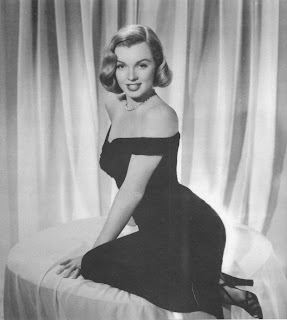






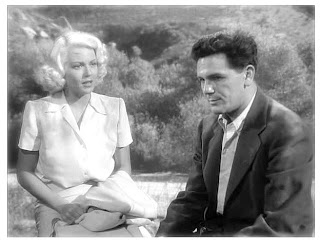

 In the film, however, Lana Turner's character even appears smiling on the road while they return walking and the scene is portrayed more as a reflective mood than disturbingly sad through a pronounced Weltschmerz impression as it's originally in the book.
In the film, however, Lana Turner's character even appears smiling on the road while they return walking and the scene is portrayed more as a reflective mood than disturbingly sad through a pronounced Weltschmerz impression as it's originally in the book.


